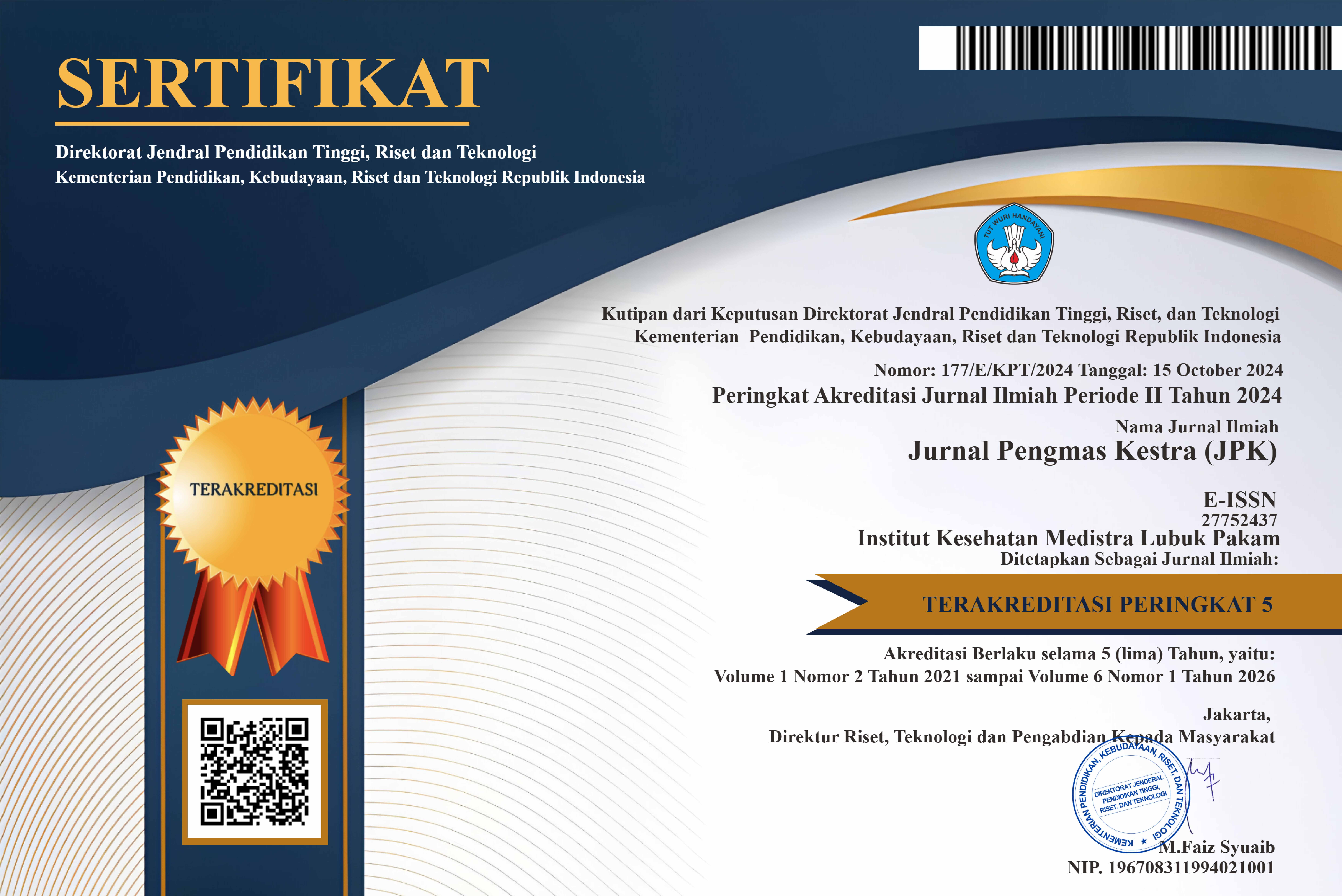Improving Education and Prevention of HIV/AIDS Transmission Among Transgender Women Through Integrated Services at Lubuk Pakam Public Health Center, Deli Serdang Regency
DOI:
https://doi.org/10.35451/jxqtjd88Keywords:
HIV/AIDS, Transgender women, Integrated Services, Health Education, Public Health CenterAbstract
Transgender women are one of the key populations highly vulnerable to HIV/AIDS transmission due to risky sexual behaviors, limited access to friendly health services, and high levels of social stigma. To address this issue, a community service initiative was carried out at the Lubuk Pakam Public Health Center (Puskesmas), Deli Serdang Regency, aimed at increasing knowledge and preventive efforts related to HIV/AIDS among transgender women through educational approaches and integrated services. The methods included needs assessment through observation and interviews, development of locally relevant educational materials, interactive counseling sessions, voluntary HIV testing (VCT), and training for healthcare providers. A total of 25 transgender participants joined the education session, and 15 underwent VCT accompanied by pre- and post-test counseling. The results showed an average increase in knowledge of 35.4% based on pre-test and post-test scores. Additionally, an inclusive HIV service corner was established, and anti-stigma communication training was conducted for healthcare workers. This approach proved effective in enhancing community engagement and improving awareness of HIV prevention among transgender individuals. Success factors included the use of visual media, community-based education, local language delivery, and strong institutional support from the health center. These findings highlight the importance of replicating similar programs in other regions, involving community peer educators as key partners. Sustained, locally tailored education is essential for effective HIV/AIDS control among marginalized populations such as transgender women.
References
[1] A. R. S. Kaliky and A. M. Ukratalo, “Penyuluhan dan Edukasi Profilaksis HIV Pra-Pajanan Di Posyandu,” vol. 2, no. 11, pp. 4999–5004, 2025.
[2] K. K. R. (2023), “Laporan Situasi HIV/AIDS dan IMS di Indonesia,” Lap. Situasi HIV/AIDS dan IMS di Indones. Jakarta, pp. 1–23, 2023.
[3] A. Kurniadi, J. A. Levy, and T. P. Johnson, “Sources of HIV information and women’s HIV knowledge in Southwest Sumba Indonesia: a cross-sectional study with mediation analysis,” BMC Public Health, vol. 25, no. 1, 2025, doi: 10.1186/s12889-024-21232-y.
[4] Z. Shaluhiyah, S. A. Qatrannada, and D. Sulistyorini, “HIV-AIDS Prevention Among Women in Indonesia and the Philippines: A Demographic Health Survey 2017,” J. Heal. Res., vol. 39, no. 2, pp. 179–188, 2025, doi: 10.56808/2586-940X.1143.
[5] Rahmawaty, Strategi Advokasi Penanggulangan HIV/AIDS Bagi Kelompok Waria Di Jakarat Timur, vol. 13, no. 1. 2023.
[6] O. Neduzhko, T. Saliuk, O. Kovtun, N. Semchuk, and O. Varetska, “Community-based HIV prevention services for transgender people in Ukraine: current situation and potential for improvement,” BMC Health Serv. Res., vol. 23, no. 1, pp. 1–10, 2023, doi: 10.1186/s12913-023-09656-5.
[7] K. T. Rossanti et al., “Profil Kesehatan Kabupaten Deli Serdang, 2023,” no. 061, pp. 1–23, 2023.
[8] F. L. Yumni, F. Firman, N. Mukarromah, S. Saputro, and R. Sumara, “Pendampingan Penderita HIV Komunitas Gay Dan Waria Melalui Pendekatan Health Belief Model Berbasis Peer Group Learning Untuk Pencegahan Penularan Hiv Bersama Pimpinan Cabang Nasyiatul Aisyiah Tambaksari Kota Surabaya, 2024,” vol. 2, no. 1, 2024.
[9] N. Fauk, M. Merry, A. Ambarwati, M. Sigilipoe, Ernawati, and L. Mwanri, “A qualitative inquiry of adherence to antiretroviral therapy and its associated factors: A study with transgender women living with HIV in Indonesia,” Indian J. Public Health, vol. 64, no. 2, p. 116, 2020, doi: 10.4103/ijph.ijph_338_19.
[10] H. Hong et al., “HIV Incidence and Transactional Sex Among Men Who Have Sex With Men in Ningbo, China: Prospective Cohort Study Using a WeChat-Based Platform,” JMIR Public Heal. Surveill., vol. 10, pp. 1–13, 2024, doi: 10.2196/52366.
[11] Centers for Disease Control and Prevention, “HIV and Transgender People: HIV Diagnoses,” vol. 2024, 2022, [Online]. Available: https://www.cdc.gov/hiv/group/gender/transgender/hiv-diagnoses.html
[12] M. M. Rahman, U. K. Alam, S. Dastider, A. Sharmin, A. T. Shimu, and C. Prabawanti, “HIV-related knowledge and risk behaviors among transgender individuals in Dhaka, Bangladesh: A cross-sectional study,” Glob. Heal. Econ. Sustain., vol. 2, no. 1, p. 1643, 2024, doi: 10.36922/ghes.1643.
[13] Y. Y. Zhu et al., “Effects of HIV Self-Testing on Testing Promotion and Risk Behavior Reduction Among Transgender Women in China: Randomized Controlled Trial,” J. Med. Internet Res., vol. 26, p. e58591, 2024, doi: 10.2196/58591.
[14] Y. Lasari, S. I. Dewi, C. Diahloka, P. Studi, I. Komunikasi, and U. T. Tunggadewi, “Strategi Komunikasi Duta Hiv / Aids Dalam Kampanye Hiv / Aids Di Kalangan Transgender Pada Ikatan Waria,” vol. 4, no. 3, pp. 473–479, 2015.
[15] S. Rosilfa, M. Anazma, I. L. Hilmi, and H. Sudarjat, “Literatur Review : Pengaruh Edukasi Terhadap Pencegahan HIV / AIDS Immunodeficiency Virus ) dan AIDS ( Acquired Immunodeficiency Syndrome ) terus menjadi,” vol. 15, pp. 12–31.
Downloads
Published
Issue
Section
License
Copyright (c) 2025 Reni Aprinawaty Sirait, Maria Silaban

This work is licensed under a Creative Commons Attribution 4.0 International License.
Copyright in each article is the property of the Author.




















